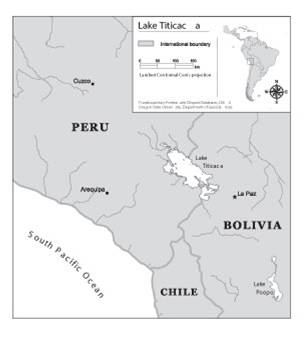Management, Protection, and Control of Lake Titicaca
| Geolocation: | -15° 47' 46.2894", -69° 22' 59.1884" |
|---|---|
| Total Population | 2,448,7902,448,790,000,000 millionmillion |
| Total Area | 111,582111,582 km² 43,081.81 mi² km2 |
| Climate Descriptors | Semi-arid/steppe (Köppen B-type), Arid/desert (Köppen B-type), Dry-winter |
| Predominent Land Use Descriptors | rangeland, religious/cultural sites |
| Important Uses of Water | Agriculture or Irrigation, Domestic/Urban Supply, Other Ecological Services |
Contents
Summary
Populations have been living around Lake Titicaca for 10,000 years, dating back to the Archaic period. The first communities appeared around Titicaca in 1,200 BC and since then have increased in population and have become more dependent on its water for their livelihood for agriculture and navigation. A series of natural occurring events took place in the 1980s which pushed the countries of Peru and Bolivia to manage the waters of Lake Titicaca in a more sustainable manner as the vulnerability of the inhabitants of the region was very high in extremely poor conditions that did not need to be exacerbated further. In the rainy seasons of 1982-3 and 1989-90, extreme droughts caused hundreds of millions of dollars in damage to the agricultural industry, both crop and animal. The years in between experienced a higher than average rainfall and culminated in the severe floods of 1986-7 causing, again, over a hundred million dollars of damage to not only the agricultural industry, but to infrastructure as well. Relations between Peru and Bolivia have always been good dating back to when they became independent nations in the 1800s. Lake Titicaca has not been a source of contention between the two states, but rather a reinforcement of their willing to cooperate with one another when their interests are mutual. The major problem; therefore, is not about conflict between Bolivia and Peru, but how to develop and improve the living conditions of the extremely poor populations who live with the Titicaca basin.
Natural, Historic, Economic, Regional, and Political Framework
 Image 1. Map of Lake Titicaca[1]
Image 1. Map of Lake Titicaca[1]
Background
Populations have been living around Lake Titicaca for 10,000 years, dating back to the Archaic period. The first communities appeared around Titicaca in 1,200 BC and since then have increased in population and have become more dependent on its water for their livelihood for agriculture and navigation.
A series of natural occurring events took place in the 1980s which pushed the countries of Peru and Bolivia to manage the waters of Lake Titicaca in a more sustainable manner as the vulnerability of the inhabitants of the region was very high in extremely poor conditions that did not need to be exacerbated further. In the rainy seasons of 1982-3 and 1989-90, extreme droughts caused hundreds of millions of dollars in damage to the agricultural industry, both crop and animal. The years in between experienced a higher than average rainfall and culminated in the severe floods of 1986-7 causing, again, over a hundred million dollars of damage to not only the agricultural industry, but to infrastructure as well.
The Problem
Relations between Peru and Bolivia have always been good dating back to when they became independent nations in the 1800s. Lake Titicaca has not been a source of contention between the two states, but rather a reinforcement of their willing to cooperate with one another when their interests are mutual.
The major problem; therefore, is not about conflict between Bolivia and Peru but how to develop and improve the living conditions of the extremely poor populations who live with the Titicaca basin. Mario Revollo of the Autonomous Bi-national Authority of Lake Titicaca gives four explanations of the principle problems the lake region suffers.[2]
Analysis, Synthesis, and Insight
Individuals may add their own Analysis, Synthesis, and Insight (ASI) to a case. ASI sub-articles are protected, so that each contributor retains authorship and control of their own content. Edit the case to add your own ASI.
Learn moreThis contribution details some of the lessons learned and creative outcomes that emerged from the resolution process.(read the full article... )
Contributed by: Aaron T. Wolf, Joshua T. Newton, Matthew Pritchard (last edit: 12 February 2013)
- ^ Product of the Transboundary Freshwater Dispute Database, Department of Geosciences, Oregon State University. Additional information about the TFDD can be found at:http://www.transboundarywaters.orst.edu/research/case_studies/Lake_Titicaca_New.htm
- ^ Revollo, M. (2001). Case Report: Management Issues in the Lake Titicaca and Lake Poopo system: Importance of developing a water budget. Lakes and Reservoirs: Research and Management, 6 (3), p. 225.



